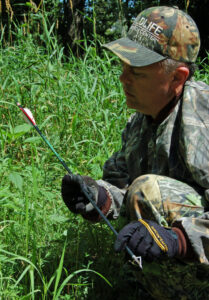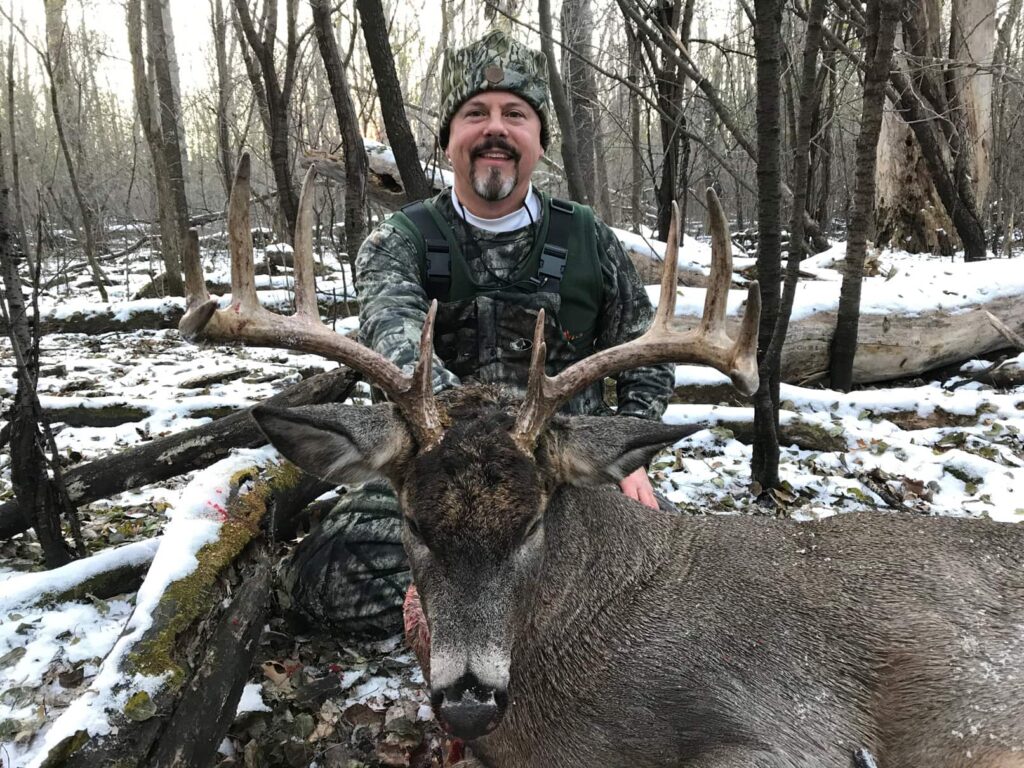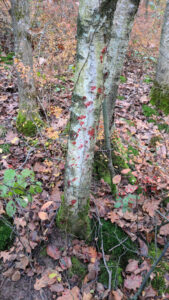A good pass-through, double-lung hit or heart shot is what every bowhunter wants. If you achieve it oftentimes you’ll watch your quarry topple over after a short distance, or at the very least you should have a very easy to follow trail. But what happens when your hit is not immediately fatal? What you do next will have a huge influence over whether or not you recover the animal. After a good double-lung hit, tracking a deer is usually simple. After a less-conclusive shot, you’ll need to master the skills of “blood-trailing” and tracking a wounded deer, and finely hone your talents of observation and deduction if you hope to recover your reward.
![]()
Marking Your Spot
After the shot, watch and listen intently. Make note of the last spot you saw the animal. Pick a landmark so you can identify and pinpoint the exact spot you last saw the animal. Choosing an identifiable landmark is important because once you get down from your treestand or out of your blind things will likely look much different.
 Continue listening after you cannot see the animal any longer – can you hear branches breaking, water splashing or a wire fence squeaking, sounds can give you further clues as to the direction of travel. Listen for general sounds, but also for specific noises that might lead you to a unique spot. Keep listening for several minutes after the shot. Often you’ll hear the animal change direction or crash and kick as it expires. Make reference points to where you heard these last sounds.
Continue listening after you cannot see the animal any longer – can you hear branches breaking, water splashing or a wire fence squeaking, sounds can give you further clues as to the direction of travel. Listen for general sounds, but also for specific noises that might lead you to a unique spot. Keep listening for several minutes after the shot. Often you’ll hear the animal change direction or crash and kick as it expires. Make reference points to where you heard these last sounds.
Seeing your arrow in flight and where you hit is valuable, but with the fast arrow speeds these days it can be difficult. Lighted arrow nocks and bright-colored fletching will help. I like to fletch my own arrows and will almost always use two white feathers and one brightly colored cock-feather. A white or bright-yellow “arrow dip” can also help. A lighted arrow knock, like a Burt Coyote Lumenok, will also make the arrow much easier to see in flight…and for that matter, afterwards when trying to recover your arrow.
Make several reference points to where the animal was standing when you shot and where you last saw it. Watch the reaction and listen intently as your quarry bolts – if they bolt at all. Pay close attention to sounds that might reveal the direction or heading.
Every now and again you’ll shoot a deer that just stands there as if nothing happened, even though they’ve been skewered with an arrow or lead projectile. With surgically sharp blades on your broadhead, and if you don’t hit a bone, an arrow can slice through a whitetail like a hot knife through butter and they may not react at all – until they topple over from blood loss. Consider yourself lucky.
If they do bolt, mark the exact spot that the animal was standing when you took the shot. If you can’t find “first blood,” use it as a reference point and line it up with the last spot that you saw the animal. This can save loads of time when you’re trying to pick up the trail.
Next, try to recover your arrow. If you can locate the arrow, examine it carefully. The color of the blood, hair samples, or the smell on the arrow can often tell you exactly where you hit. Dark-red blood typically means a liver hit. Pink, frothy blood almost always means a lung hit. Bright-red blood may be heart, arteries, or muscle — in this case, the volume of blood you see is a good indication of which. If you suspect a gut shot, you should detect a foul smell on the arrow. If the arrow is still in the animal this could lead to other important clues down the trail.
How Long To Wait Before Tracking
Unless you saw the animal expire, I suggest leaving it for at least an hour. In fact, I often don’t bring my camera or field-dressing equipment with me so I have to take the time to return to my vehicle to get it. This helps me avoid the temptation to get on the trail immediately, which usually isn’t wise.
Many other places on a whitetail offer lethal hits. It’s not humane to try for those shots, but sometimes it happens. With a gut shot, back out and give the animal at least six hours. This is usually a lethal hit, but if you push the animal your odds of recovery decline precipitously. A liver hit, characterized by its dark-red blood, is also lethal, but again, you need to give the animal time — I suggest at least three hours.
If you give the animal that time, more than likely you’ll find it dead in its first bed, which should be less than 200 yards from the hit. The blood on a muscle hit often resembles heart or artery blood but there will be much less of it. You’ll know if you hit a major artery or vessel. The occasional drop of blood can also resemble a gut-shot where fat or intestines can plug the exit hole. A gut shot may also have a brown tinge to it.
Again, this is NOT a shot we’re ever going to attempt, but a glance off of a branch can happen to the best archer. A hit in a hind-quarter will depend upon precisely where you hit, but all you need is to knick the femoral artery and the animal will likely bleed-out within sight.
Otherwise, you’ve created a huge problem and possibly a very long trail. If you expect a hit in the “ham” there are two ways you could go – if the animal can bed comfortably – if you don’t push him, the first bed will likely be close. However, as you can imagine, this could be very uncomfortable and you may see them switch beds often as they try to get comfortable. You MUST follow all trails until you exhaust all possibilities or you’re confident the animal will survive.
My theory on a muscle hit differs from some. Normally, you would want to let the animal bed down and bleed to death. With a muscle hit, if the animal beds down, chances are the wound will start to heal. With this hit, I suggest hitting the trail to pursue the animal fairly quickly. Don’t let up, be steady and ruthless. Keep pushing until you can either finish off the animal or you know it will survive.

Another exception to the “give the animal time” rule is in cases of inclement weather. There are two rules of thought on this and either way may be fine. If rain or snow is moving in, some will scratch the usual wait time and take to the trail immediately. Only if they bump the animal out of a bed will they retreat and wait longer. Fresh sign is so much easier to track than that which has been diluted and wet or covered by snow.
Temperatures may also have an impact. Obviously, anytime there are warm temperatures, you want to recover the animal and cool down the meat ASAP. So this may also influence how quickly you go on the trail.
Others might say that if you go on the trail right away you risk bumping the animal out of a bed. Look…if you made a decent hit, that animal should be dead in the time it took you to read the last two paragraphs – so the more pristine the trail, the easier the recovery. I tend to slowly “test the trail” until the sign or the animal shows me I should give it more time.
Observations On The Trail
On tough trails, examine every tiny clue carefully. If a track is not evident, inspect blood splatters for the direction of travel. Remember that blood sign may not only be on the ground, whitetails brush up against many objects like trees, brush, and tall grass. An extra set of eyes and different perspective can yield huge results when you’ve run through all other options.
One thing I have learned after being on hundreds of wounded-deer trails – they almost always “head home” if they suffer a wound that’s not immediately fatal. In this case, a buck will almost always head toward his primary bedding area. Scouting, trail cameras and knowing the buck you’re hunting obviously helps here.
 While some tracking help is great and will help immensely, too many people can have the opposite results. Everyone wants to be the first person down the trail (just like me), after all – it’s very exciting! But in that rush of scrambling for the front of the pack you may be destroying valuable clues. The rule we use is the hunter who made the shot is always first on the trail or gets to choose who goes first.
While some tracking help is great and will help immensely, too many people can have the opposite results. Everyone wants to be the first person down the trail (just like me), after all – it’s very exciting! But in that rush of scrambling for the front of the pack you may be destroying valuable clues. The rule we use is the hunter who made the shot is always first on the trail or gets to choose who goes first.
Just like a CSI detective that tells the rookie to get out of the area so they don’t destroy evidence, the same goes for a blood trail. Especially on afternoon hunts when you’re tracking at night, you’re often destroying more sign than you can see.
Three, maybe four people tops is perfect for a blood trail.
Go slow! If you get to the point where you’ve lost the sign and you’re going to search a grid pattern, then the more people the better. The more “eyes” you have the better your odds, but if you have sign on a trail, more people often extinguishes fresh sign.
If you’re on a difficult-to-follow trail, carry small pieces of ribbon, toilet paper, or something else visible you can use to mark new sign and keep you on line. If you lose the blood trail, lining up those markers and following the same heading will usually put you back on track. It all depends on how easy the trail is to follow — if you can go at a constant walking speed, you can simply have your tracking buddy stand by the last sign. When the sign is harder to come by, marking the trail can be very helpful.
If you’re on an afternoon hunt and dark is approaching, you’ll have to be the judge of how good your hit was. Unless you’re confident in a lethal hit, it’s almost always a good idea to back out and come back at sunup, especially if you’re on a tough trail.
I’m confident that a whitetail, especially a mature buck, knows when it’s being pursued and trailed. I’ve seen them accomplish some amazing feats that I swear were done specifically to throw me off of the trail – like walking down a creek or through extended areas of water, backtracking down the same trail and then heading off 90 degrees, circling in the same track multiple times in a small area, or laying tight to the ground and waiting for me to pass by.
![]()
Using Dogs for Tracking a Wounded Deer
Where/when legal, I’m a BIG advocate of dogs to help with recovery – especially one that has been specifically trained for blood trailing. My yellow lab Annabell, although she has no training in recovering deer, she’s helped me locate a couple that I don’t believe I would have found without her.
When you’re on the trail of a wounded animal, remain unrelenting and open-minded. Kids have amazing eyes – bring them along, besides being able to see what I often cannot, they bring a different perspective and it also teaches them the facts of life and where their food comes from! If the trail doesn’t lead you to the animal, you can always search a grid pattern in a last-ditch attempt to find it. Persistence and effort will lead you to just as many downed animals as a blood trail will.
For more on blood trailing deer check out episode 66 Happy Blood Trails on the GameKeeper Podcast
Join our weekly newsletter or subscribe to GameKeepers Magazine.
Your source for information, equipment, know-how, deals, and discounts to help you get the most from every hard-earned moment in the field.







